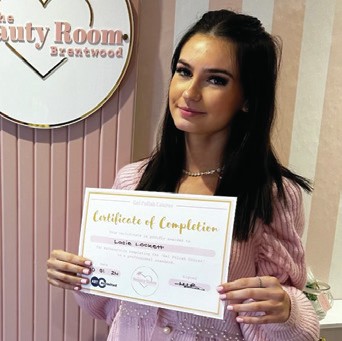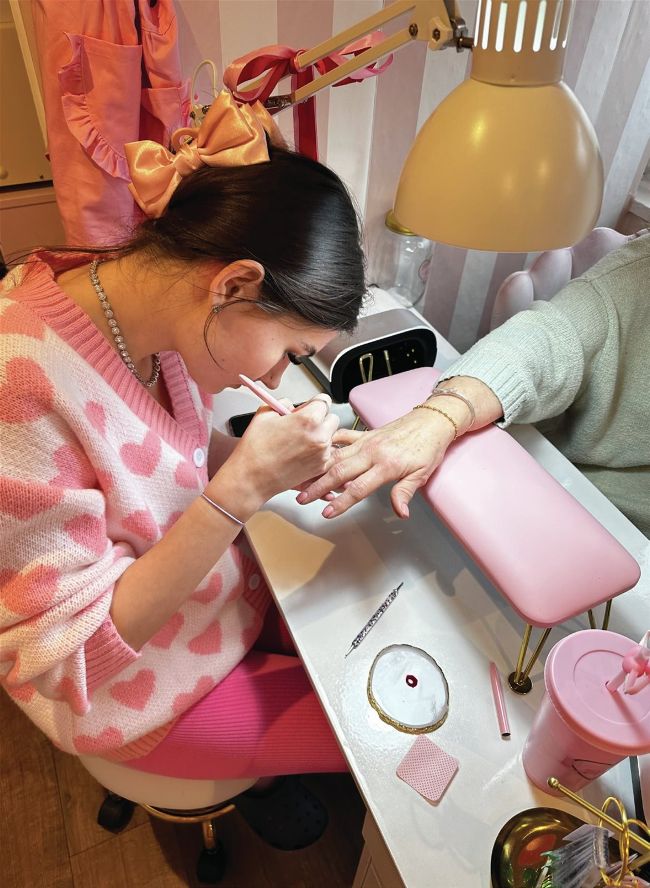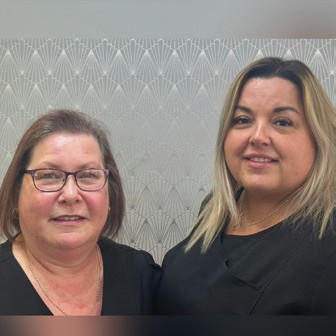BUSINESS MATTERS
Nurturing the next generation
Explore the logistics & benefits of the apprenticeship process, as REBECCA HITCHON chats to salon owners that have reaped its rewards
Rising costs have been affecting businesses and their ability to onboard, and the impact of this on apprenticeships is sparking discussions across the nail and beauty sector. The UK government’s Spring Budget at the start of March prompted dismay from industry bodies for its silence on support for apprentices. However, positive news came later in the month when the government announced plans to fully fund the cost of apprenticeships for small and medium-sized enterprises (SMEs).
But why are apprenticeships beneficial? “With apprenticeships open to applicants aged 16 upwards, they provide clear direction and motivation to those who know they want to pursue a career in the beauty, holistic and wellbeing industries,” notes a spokesperson for the British Association of Beauty Therapy & Cosmetology (BABTAC). “Hands-on experience is invaluable, as is learning from peers, appreciating how a business runs from the bottom up and integrating with clients day in, day out.” What’s more, apprentices learn as they earn and businesses can foster loyal, homegrown and fresh talent, boosting their brands.
Apprenticeships in England
Vacancies for apprentices in England are posted on the National Apprenticeship Service at www.gov.uk/apply-apprenticeship. Apprentices can work for up to 40 paid hours per week and ideally no less than 30 hours each week. They cannot work less than 16 hours per week. This employment includes off-the-job training, for example at a college or training provider (but not including English or Maths training), which accounts for 20% of their time.
The first stage of an apprenticeship: on-programme training, lasts a minimum of 12 months. This is where an apprentice learns job-specific skills and knowledge, before entering the Gateway stage. Here, the employer and if appropriate, training provider, decide if the apprentice is ready for the end-point assessment (EPA). This final stage is carried out by independent end-point assessors (IEPAs), who examine whether the apprentice has developed the skills, knowledge and behaviours outlined in the apprenticeship standard. This is a template for how the apprenticeship should be approached, detailing the skills required for the role being trained for. Standards are developed by employer groups known as ‘trailblazers’.
Apprenticeships work differently throughout the UK. In Wales, there are three types of apprenticeship: foundation apprenticeship (level 2), apprenticeship (level 3) and higher apprenticeship (level 4). In Scotland, there is no beauty apprenticeship, but levels 5 and 6 Hairdressing and Barbering apprenticeships. In Northern Ireland, apprenticeships in Hairdressing, Barbering, Beauty Therapy, Nail Services and Spa Therapy are available at levels 2 and 3.
Before employing an apprentice, businesses must be diligent and ensure that the apprentice has the right to work in the UK, is paid the apprenticeship rate or National Minimum Wage, their health & safety is prioritised and an apprenticeship agreement has been signed. This agreement is law and must include details like the length of the apprenticeship, its training and the qualification being worked towards.
NEWS FLASH
From 1 April 2024, the UK government began fully funding the cost of apprenticeship training for 16 to 21 year-olds in SMEs. Financed by a £60 million investment to enable up to 20,000 more apprenticeships, the decision followed calls by beauty industry bodies to introduce greater incentives for small business owners to engage in apprenticeship programmes and support the retention of staff.
Another measure that has been unveiled is an increase to the funding that employers who pay the apprenticeship levy can pass onto other businesses. Large employers who pay the levy are now able to transfer up to 50% of their funds to support SMEs to take on apprentices.
Victoria Brownlie, chief policy officer at the British Beauty Council, attended the SME Business Connect conference in Coventry, where UK Prime Minister, Rishi Sunak, announced the measures. She comments: “The announcement is a real win for our industry as a significant employer of young apprentices.
It addresses the concerns we had raised with the government, in terms of where support was lacking when it comes to encouraging small salons and beauty businesses to invest in our future skilled workforce.

Victoria Brownlie
“Where further focus is required however, and this is something we continue to raise, is the need to not lose sight of the importance of investing in older learners, who carry a larger cash burden for businesses. This is vital for reskilling, maintaining a diverse workforce and ensuring we are providing opportunities for all.”
CASE STUDY: Nailspa, West Yorkshire
“As a business owner, I believe that when it comes to employees, you cannot beat ‘growing your own’. Nailspa has been employing apprentices for over 20 years and is run by two former apprentices. Others have gone on to own successful businesses, so I highly recommend the apprenticeship route,” smiles Belinda Price, OPI UK&I education manager & owner of Nailspa, Huddersfield, a finalist for Nail & Beauty Salon of the Year in the Scratch Stars Awards 2024. “An apprenticeship is your opportunity to develop a person’s skill set, life experience and career. If you can onboard and train an apprentice in a few treatments quickly, they will grow in confidence and soon bring revenue into your business, plus they will find their niche sooner. The hope is that they become an essential part of the team, who clients love and come back to, therefore growing your company.”

Belinda Price
Belinda notes that the Nailspa team has a favourite local training provider, but she has advertised for apprentices and had prospective apprentices contact her directly in the past, as well as been contacted by the provider. She recommends employing someone local, as transport can present an issue when the apprentice is 16.
“Usually, we find an apprentice then contact the college, which arranges induction meetings, including a health & safety visit,” Belinda continues. “I always suggest a trial period or probation once employment starts and prior to that, propose some Saturday work or trial days. Once contracts are in place, the apprentice will start Nailspa’s onboarding programme. Initially, the role will involve a lot of drink making and reception work, but that is the best way to get to know clients. Once the apprentice is carrying out treatments, clients will be more likely to choose them, as they made them feel welcome. As the apprentice works through their college units, we support in the salon.”
Are you considering taking on an apprentice? Belinda recommends asking yourself:
• Can you afford to hire?
• Can you dedicate time to the apprentice? “The more training, supervision and support you can give, the greater the reward,” Belinda notes. “If you are are taking on a school leaver, all they know is school and home. You must find a way to sit in the middle, giving them some responsibilities and keeping them engaged.”
• Will the team welcome them? “I once described gaining an apprentice to my team as having a new little sibling or cousin; they need to nurture and support them and give them their time,” says Belinda.
• Can you give the apprentice a vision? “Make sure they know what you are both aiming for,” Belinda continues. “Some training and tasks can appear pointless if you don’t explain. Plan regular meetings and make sure they feel part of the team and invested in.”
www.belindapricenailspa.co.uk
“An apprenticeship is your opportunity to develop a person’s skill set, life experience and career.”
Belinda Price, OPI UK&I education manager & owner of the Nailspa salon, Huddersfield
CASE STUDY: The Beauty Room Brentwood, Essex
“It was a bit of luck that brought apprentice, Lacie, to my business,” reveals Harriet Lewis-Brooks, owner of The Beauty Room Brentwood. “After expanding my studio to include another nail desk, a local academy asked if I would be interested in employing an apprentice. Two interviews were arranged: one of which was with Lacie, and we instantly clicked. Lacie had lash and brow experience and was so proud of her work, which was an indicator of her passion. This also meant that I could delve into training her on the salon’s specialism: nails. The academy gave me all the information I needed and dealt with the paperwork.”

Harriet Lewis-Brooks
Lacie Lockett, 16, has been an apprentice at The Beauty Room Brentwood since January and had no previous experience in nails before joining the team. “We explored gel polish on her first day, as in her Level 2 Beauty Therapy college training each Monday, this isn’t covered,” shares Harriet. “I am an educator so was able to train Lacie in this, then we moved onto builder gel treatments, nail art and French tips – which she is particularly skilled at creating.”
Each month, Lacie’s tutor visits the salon, interchanging between hosting a review with Lacie, where the apprentice can discuss any issues, and one-to-one time focused on specific topics. Harriet has been using this time to model for Lacie for case studies she must prepare. The salon owner has also been putting government funding towards extra training to ensure Lacie is educated in areas her college cannot offer, which are tailored to The Beauty Room Brentwood’s needs.
“After leaving school, I changed career paths, which I think was a blessing in disguise as I then found this apprenticeship,” Lacie beams. “I get so much joy out of the beauty industry and find offering treatments to be incredibly rewarding. Working at The Beauty Room Brentwood has helped my confidence grow a lot, especially through dealing with clients. The salon’s clients are a range of ages, so the apprenticeship is teaching me how to effectively communicate with them all. Harriet is always available to help and offer reassurance.” Lacie is learning a variety of beauty skills via her college training, and Harriet has also invited her to bring new treatment ideas to the business.

Lacie Lockett

Lacie practicing her nail skills.

Nail looks by Lacie.
“Having the extra pair of hands has been great and will be particularly helpful at Christmas, as Lacie has no college sessions in December in order to help with the festive rush,” Harriet details. “Teaching is my passion and a focus this year, so the apprenticeship has allowed me to work on that, while transforming my studio setting into more of a salon environment. It has required a lot of organisation to ensure Lacie is clear about her schedule and has time to practice and learn with me. For example, I ask Lacie to take photos of her work, which I annotate with targets for her to strive towards. It is also important for her to troubleshoot, for example dealing with a late client, smudged nail or nail repair.”
For anyone interested in an apprenticeship, Lacie urges not to feel disheartened if a suitable one is not found instantly. “Discovering your beauty specialism is trial and error, so make this push you to find the right path, stay committed and you’ll achieve the end result you desire,” she concludes.
DID YOU KNOW?
Research shows that 80% of apprentices remain in industry employment, and 64% continue with the same employer after their apprenticeship.
CASE STUDY: So Beautiful, Cambridgeshire
“We began introducing apprentices in 2015 when So Beautiful opened, as we wanted to provide therapists with the knowledge, skills and behaviours required for our business – which we hadn’t always seen in other salons,” Alison Abbott & Georgina Atkins say joint partners of the St Neots-based company, “Alison supports practical training and Georgina’s background is in education.

Alison Abbott and Georgina Atkins.
“Apprenticeship standards support us in new methods of working and push all salon members to ensure they are up-to-date with industry requirements,” the pair continues. “By taking on apprentices, we’ve gained work-ready, confident and competent employees with an extremely professional approach. Usually, our apprentices start as school leavers that work for us on Saturdays or late evening support workers, who gain experience watching treatments and customer service interaction, and help us open and close. From this, we can see if they fit the job description and have a hunger for learning and the beauty industry.”
Alison and Georgina note that making significant time to support apprentices is a key element to their success. “We arrange regular training with a range of therapists to ensure apprentices see the different ways to perform treatments and skills required. We also nominate salon mentors to be a part of their journeys,” they comment. “It’s crucial to give time to work on apprentices’ practical skills, knowledge and behaviours, so these can be showcased in their portfolios and evidence.”
www.sobeautifulstneots.co.uk
“By taking on apprentices, we’ve gained work-ready, confident and competent employees with an extremely professional approach.”
Alison Abbott & Georgina Atkins, owners of the So Beautiful salon, Cambridgeshire
LEARNER LOWDOWN
“My Advanced Level 3 Beauty Therapy apprenticeship has improved my confidence greatly. By learning on the job, I’ve absorbed information, learned new skills and had the opportunity to work with others.”
Current So Beautiful apprentice, Kayleigh Jones
LEARNER LOWDOWN
“I enjoyed the apprenticeship route because I was able to gain industry experience. I liked having access to insight from So Beautiful’s therapists on my treatment techniques.”
Former So Beautiful apprentice, Morgan Page